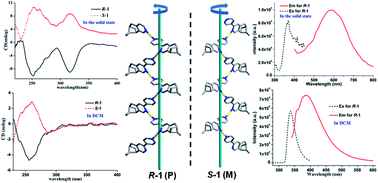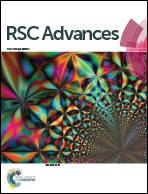A pair of 2D chiral Ag(i) enantiomers with dual chiral elements: syntheses, structures, and photoluminescent and chiroptical properties†
Abstract
In this work, two new enantiopure bis-monodentate N-donor chiral ligands, namely (−)/(+)-2-(4′-pyridyl)-4,5-pinene-pyridine (LR/LS), have been designed and synthesized. Using LR and LS as bridging ligands to react with AgClO4, a pair of novel 2D chiral Ag(I) enantiomers formulated as [Ag2(LR)2(ClO4)2]n (R-1) and [Ag2(LS)2(ClO4)2]n (S-1) were isolated and characterized. In R-1 and S-1, each Ag(I) ion is bonded by two N atoms from two different chiral LR or LS ligands, leading to the formation of 1D right- or left-handed –L–Ag(I)–L– helical chains. Moreover, two adjacent helical chains are further doubly linked by two monodentate ClO4− anions through weak Ag–O contacts to form 2D network structures, in which dual chiral elements, i.e., center chirality and helical chirality coexist. Interestingly, each free ligand LR/LS and R-1/S-1 enantiomers show very different ECD spectra in the solid state and in solution, which are correlated to the intermolecular interactions and molecular structures in each state, respectively. Notably, as a representative, R-1 exhibits intense room temperature photoluminescence both in the solid state and in solution with different emission features and mechanisms, while it also shows more intense emission than that of free ligand LR. In particular, R-1 and S-1 represent the first examples of 2D Ag(I) chiral coordination polymers (CCPs) supported by ClO4− anions, possessing dual chiral elements.



 Please wait while we load your content...
Please wait while we load your content...